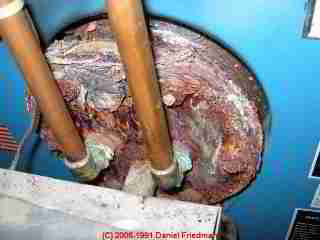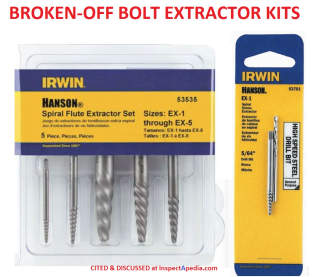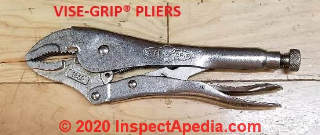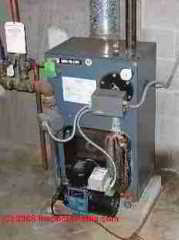 Leaks at tankless coils: location, cause, detection, fix
Leaks at tankless coils: location, cause, detection, fix
How to Diagnose, Evaluate & Repair Leaks at a Tankless Coil on a Heating Boiler or in an Indirect Water Heater
- POST a QUESTION or COMMENT about the types of leaks that occur on tankless coils, where they are found, what problems the leaks cause, and a leaky tankless coil can be repaired, or if necessary, replaced.
Tankless hot water coil leaks, corrosion, & repair procedures:
In this article series we explain how to spot, evaluate, and repair leaks at the tankless coil used on heating boilers to provide domestic hot water or leaks in the hot water heating coil used on indirect-fired water heaters.
Leaks can occur at a tankless coil where it is mounted to the top or side of a heating boiler or water tank (if an indirect water heater is in use), at fittings connecting hot and cold water piping to the coil, and more subtle leaks can occur inside the boiler or water tank - leading to excessive boiler pressure and to dangerous TPR relief valve leaks.
InspectAPedia tolerates no conflicts of interest. We have no relationship with advertisers, products, or services discussed at this website.
How to Find, Diagnose & Fix Leaks at Tankless Coils & Indirect Water Heater Coils
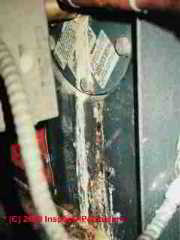 Leaks at tankless coils on heating boilers can seep away for a long time before anyone notices. But if you wait too long, the boiler may be beyond repair.
Leaks at tankless coils on heating boilers can seep away for a long time before anyone notices. But if you wait too long, the boiler may be beyond repair.
This article provides a guide to recognizing and evaluating leaky boilers. How to evaluate the severity of leaks at a hot water tankless coil. Why leaks at a tankless coil can ruin a heating boiler. How to inspect repair leaks at tankless coils on heating boilers.
We address these tankless coil leak questions: When is a tankless coil leak or indirect water heater coil leak repairable? Leaks at the tankless coil mounting plate can often be repaired if caught early.
Severe rust at a tankless coil mounting plate means tankless coil replacement is impossible and the boiler may be ruined. When is boiler replacement necessary? How to diagnose a tankless coil that leaks into the heating boiler.
[Click to enlarge any image]
Common locations of external leaks at or around tankless coils on the heating boiler that leak out of the coil or boiler or indirect water heater
Boiler leaks out at a tankless coil mounting plate or at the pipe fittings that pass through the coil mounting plate are a common defect on heating boilers, both steel and cast iron units. You may not see water (the boiler is hot, after all) but you'll see mineral deposits and crud or even crud and rust build-up at the leak source and below it.
Watch out: aught and repaired early these leaks at a tankless coil can be repaired without serious damage to the heating boiler. Left alone these same leaks, particularly at the tankless coil mounting plate can completely destroy the heating boiler.
Deciding how badly a heating boiler has been damaged by leaks is tricky, controversial, and important since both safety and big cost concerns are involved.
- At the tankless coil face tapping for mounting a temperature sensor (bottom center pipe shown in this photo, leading to a boiler combination control).
- At the tankless coil face tapping for the incoming cold water or outgoing hot water pipe (the two copper pipes shown in this photo)
- At the tankless coil mounting plate where it is bolted to the face of the heating boiler (the round and rusty steel face shown in this photo) or at the heat exchanger coil mounting plate on the side or bottom of an indirect fired water heater
Leaks at the heating boiler - coil: A leak at any of these points will not normally show up as water on the boiler or on the indirect water heater or on the floor around the boiler or around the indirect fired water heater. That's because the boiler is normally hot all of the time. Water leaking at any of these locations on a heating boiler will rapidly evaporate.
Leaks at the indirect fired water heater: Water leaking out of the coil mounting plate or fittings on an indirect fired water heater may appear as a puddle on the floor or it may be absorbed in water heater insulation where it is evaporated - for a time, until the leak gets bad-enough to show up externally.
How to Evaluate an External Leak at a Tankless Coil on a Heating Boiler
Young leaks at a tankless coil can be repaired
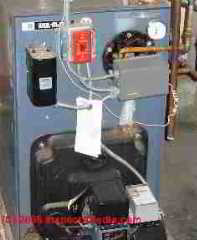 If a leak is found in time, that is, before severe rusting and exfoliating or flaking rust have occurred, it should be possible to disassemble, clean, seal, and re-assemble the parts.
If a leak is found in time, that is, before severe rusting and exfoliating or flaking rust have occurred, it should be possible to disassemble, clean, seal, and re-assemble the parts.
In our photo at left we'd probably call this a "middle-aged" leak rather than a "young leak" because the white mineral salt deposit you see below the tankless coil on the face of the boiler is pretty thick.
But it's possible that this tankless coil leak can be repaired
A closer inspection is needed.
- Leaks at piping connections on the tankless coil itself can be repaired without removing the whole coil assembly from the boiler.
- Leaks at the tankless coil mounting plate will require that the boiler be shut down, drained, and water piping connections cut or opened at the coil so that the coil assembly can be removed.
If inspection shows that the coil face and boiler mating face are un-damaged, the mounting gasket is replaced, sealed, and the coil reassembled to the boiler.
This may seem an odious task, since it means you'll need to shut down the boiler and also domestic hot water, and boiler water and piping water may need to be drained or partly drained in order to make this repair.
But you should make this repair as soon as possible.
Old leaks at a tankless coil may require boiler replacement
If a leak is not found in time, or if no one was willing to repair a young leak, the cost is likely to be very high.
Leaks at piping connections through the face plate of the tankless coil, if they have progressed for a long time, will have caused so much corrosion that disassembly and repair of the coil is impossible.
The good news is that leaks at this location only destroy the tankless coil itself and are less likely to destroy the whole heating boiler. The coil will need to be removed and replaced.
The white deposits on the face of this tankless coil appear to originate at a pipe connection at the coil face (top center of the photo); but notice that second leak trace to the right of the white one?
This tankless coil may also be leaking at its gasket. Our next photos show how prolonged leaks at the coil face plate mounting gasket can destroy a heating boiler.
What evidence of leaks will we observe at a boiler with leaks at the tankless coil?
White or other mineral salts left behind from evaporating leaky water, at and below the point of leakage, often staining the face of the boiler, such as we show in the photograph above.
Even without close inspection one can observe white leak stains below the round black tankless coil plate and running down the face of the boiler in this installation.
Rust or corrosion at the point of leak, such as the flaking exfoliating and badly rusted tankless coil we show in our photograph at left. .
A leak that has produced rust like this might mean that the tankless coil unit needs to be replaced, or worse, that the boiler has been so damaged by rust that it is beyond repair.
Our next photos show how prolonged leaks at the coil face plate mounting gasket can destroy a heating boiler.
Photo Guide to Severe Tankless Coil Leak & Rust Damage
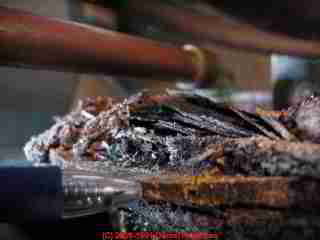 Leaks at piping connections through the face plate of the tankless coil, if they have progressed for a long time, will have caused so much corrosion that disassembly and repair of the coil is impossible.
Leaks at piping connections through the face plate of the tankless coil, if they have progressed for a long time, will have caused so much corrosion that disassembly and repair of the coil is impossible.
The good news is that leaks at this location only destroy the tankless coil itself and are less likely to destroy the whole heating boiler. The coil will need to be removed and replaced.
Severe Leaks at the tankless coil mounting plate, if they have progressed for a long time, will have caused damage to the coil mounting plate.
But much worse, the mounting surface on the boiler will also be damaged. If the boiler surface has been damaged it may be impossible to mount a replacement tankless coil without continuing leakage.
It is technically possible to perform a repair to such a boiler by welding on a new coil mounting surface, but the welder is not going to be very interested in performing such a small but time consuming repair, and knowing that the alternative to her welding service is a whole boiler replacement, the price for the welding job may be rather high.
Reader Comments, Questions & Answers About The Article Above
Below you will find questions and answers previously posted on this page at its page bottom reader comment box.
Reader Q&A - also see RECOMMENDED ARTICLES & FAQs
On 2022-04-01 by Inspectapedia Com Moderator (mod) - Evaluate the risk of a catastrophe before taking apart leaky parts on a boiler but also compare the risks of loss of heat or flooding
@Mark Rist,
I don't think that the auxiliary valve position will fix the corroded leaky mating joint between the tankless coil and the heating boiler, but
Do take a close look to see exactly where the leak or leaks are occurring as that's an important detail in deciding how to proceed.
And report on the extent of corrosion - its seriousness - and on the degree of rust at the tankless coil mounting bolts.
Watch out: I agree completely that taking apart any old plumbing component risks opening a can of worms, as you may find that a nut or bolt snaps off or that threaded parts are so corroded that re-assembly is impossible, leading to need for an expensive replacement.
Just yesterday we discussed a leak at an elbow that in my opinon ought not even be in place, on a 1990s gas fired boiler in northern Minnesota. The TPR valve needs replacement. The valve is mounted on a 90 degree elbow on the boiler where usually the TPR is mounted directly to the boiler.
The tech said they NEVER are willing to touch such parts, for just the reasons we've given. They get blamed for what was a pre-existing condition but note that touching the part results in a boiler replacement and a furious customer.
On the other hand, and here's the rub, leaving the leak un-attended will ultimately destroy the boiler.
See our photo below of a steam boiler from a New York home - it was completely destroyed and its cast-iron literally rusted through, afrter the homeowner ignored boiler leaks for years. I'll attach a photo below.
So in our OPINION here's the critical decision you and your service tech would make:
1. Is the existing corrosion and rust so bad that there is a significant chance that trying to disassemble the parts will lead to a total failure and need to replace the whole boiler?
If not, give it a shot. With appropriate and due warnings.
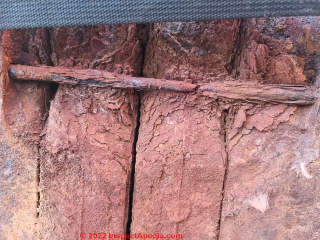
Details about the terribly rusted boiler whose sections are shown above are given
at BOILER LEAKS CORROSION STAINS
When do we let the boiler alone and ignore the leak ? What's the cost? What are the risks?
2. If the parts are so corroded that a replacement of the whole boiler might be required, what's the cost of ignoring the problem until we see water on the floor?
Answer, as was experienced by the homeowner of the boiler we show in our photos.
2.a. The leaky corroded heating boiler is most-likely to fail when it's working the hardest, hottest, under longest periods of highest pressure: during the peak of the heating season on the coldest days of the year.
That's what this homeowner experienced. The result was a boiler that was so leaky and deteriorated what when the homeowner called for emergency service the heating tech took one quick look at the boiler and shut it down for safety, worrying that the whole unit could explode or burst or flood the home's basement. Deeming the unit unsafe he red-tagged it.
The homeowner was then without heat for several days until the heating service company could locate, obtain, and bring a new boiler to the site for a replacement job.
2.b.There was a further risk that the home's basement could be flooded by leakage - mitigated if the service company or homeowner were able to turn off the water supply to the now shut-down and red-tagged boiler.
There were additional costs as well. Because the boiler had to be replaced on an "emergency" basis, the boiler and its installation cost more than it might had it been replaced at a more-opportune time, such as mid-summer.
Our photo, above showed how the cast-iron sides of the boiler were rusted through.
This boiler was beyond repair by the time the homeowner called for repair service.
Sometimes a leaky gasket at a tankless coil can be replaced by removing the coil, cleaning the surfaces, and installing a new gasket + sealer.
But if you see thick exfoliating rust and corrosion, even before there's water on the floor, there is are some critical questions to answer:
- where is the rust? Only on the part to be removed or also on the mating surfaces of the boiler?
- how bad is the rust? Is it surface rust - the parts can probably be removed successfully, or is there thick exfoliating flaking rust - the parts may meet with disaster on trying to execute the repair
- what are the surrounding conditions? Is it very cold? Can the building be without heat for a time? What are the potential costs and risks of a more-serious leak or of a loss of heat that may occur if the repair is deferred?
- would it be better to wait for warmer weather to perform the repair?
Bottom line: if you can fix a leak in time to avoid destroying the boiler, it's worth giving that a shot.
@Mark Rist,
Please post some sharp photos of your tankless coil, including the whole boiler face, the coil, and the area of leakage - 1 photo per comment, as many comments as you need.
On 2022-04-01 by Mark Rist - The coil "Gasket" has a whole lot of 'calcium' build-up, it would be a bad job just to get to it
The coil "Gasket" has a whole lot of 'calcium' build-up, I was thinking the gasket needs to be replaced, but it would be a pain in the A#$ just to access it.
There was an 'auxiliary' valve in line with the 'mixer' which brought more hot water to the mixer. Would this added (pressurized) water cause some 'back pressure' on the 'auxiliary' valve causing the water to 'bleed' out of the gasket? The 'mixing' valve also was leaking with calcium (white crud).
The reason I'm asking is if the 'auxiliary' valve is in the 90 degree (off) position, then less pressure (hot water) goes to the mixing valve & less backpressure to the coil gasket; therefore no leak. I really DON'T want to "F' with this, me or pay someone else too!
I'm hoping it will run just fine as long as this 'auxiliary' valve is left in the off position. Any thoughts would be greatly appreciated. Thanks, Mark
On 2022-03-25 by Inspectapedia Com Moderator (mod)
@Christos,
Thanks for the nice comment; we work hard on this material for accuracy and trust so we're really grateful when readers find it useful. Comments, questions, suggestions always help too.
On 2022-03-25 7 by Christos
Thank you for you are the best!
Question: how to fix a broken-off tankless coil mounting bolt
I twisted off middle bolt front of New Yorker furnace domestic water coil to replace a gasket. What to do?
This Q&A were posted originally at TANKLESS COILS
Moderator reply: Options for repair of a broken-off Tankless Coil Mounting Bolt
Mac
Leaky Tankless Coil Repair: How to extract a broken-off bolt at the Tankless Coil
Don't feel bad, you're not the first to break off a bolt. Good news is that there's no problem we're likely to have on a mechanical system that nobody has faced before, and usually somebody has figured out a great solution.
There are several options to salvage the situation.
1. Use Vise-Grip Pliers to Turn the Broken-off Bolt
IF all of the other bolts can be removed and you can remove the tankless coil assembly,
THEN
IF you can get a good bite on the now protruding bolt with a Vise Grip® pliers,
THEN
 AFTER you soak the fitting with Liquid Wrench for 1 few hours or longer
AFTER you soak the fitting with Liquid Wrench for 1 few hours or longer
THEN see if you can simply turn out the bolt.
2. Tap to Rotate the Broken Bolt
IF there is not enough protruding bolt to get a grip on it and turn it out, you can
Try the Liquid Wrench treatment followed by carefully tapping the face of the bolt on an oblique angle to see if you can get it to turn out (tap counter-clockwise or to the left.
3. Use a Bolt or Screw Extractor
You can step out, wearing your COVID face mask, to a local hardware store where you buy a spiral flute extractor set also referred to as a screw or bolt extractor set.
You'll need a hard carbide tipped drill bit set of a diameter that's about half that of the diameter of the bolt and a screw extractor or - basically a very hard steel coarse-reverse-threaded or "fluted" device (shown above, manufactured by Irwin / Hanson, also produced by other manufacturers.
You will note that you can buy an individual bolt or screw extractor of the right size, sold packaged together with the appropriate high speed drill bit.
Drill a hole in the center of the bolt, then tap in the screw extractor and turning it counterclockwise, back out the bolt.
(Pre soaking with a liquid wrench type product can help the extraction)
4. Drill out the broken bolt and re-thread the bolt hole
 In the worst case, I've had to drill out the entire bolt, using a succession of carbide-tipped drill bits and drilling slowly - you should see curls of steel coming off of the bit.
In the worst case, I've had to drill out the entire bolt, using a succession of carbide-tipped drill bits and drilling slowly - you should see curls of steel coming off of the bit.
Watch out: If you run the drill at high speed all you do is overheat the bolt and bit and dull the bit quickly. Press hard and drill slowlhy.
Use a succession of bits, starting at the *center* of the bolt, until you've drilled out to just short of cutting into the original threads of the opening.
Then you'll use a tapping tool to chase out the remnants of the old bolt and clean up the threads.
If, as I've done, you over-drill the hole so that it's too big for threading-in an original-sized coil mounting bolt, then you can often recover by drilling and tapping the hole for the next-size larger bolt.
Watch out: before going to all this trouble, inspect the coil mounting area on the boiler.
If it's so badly rusted that a new coil isn't going to seal properly then (although you could hire a welder to try repairing the area) it's probably time to either abandon the tankless coil and seal up the coil opening entirely OR it's new boiler time.
So before starting all this take a look at
TANKLESS COIL / HOT WATER COIL LEAKS
Irwin/Hanson and other manufacturers sell screw and bolt extractor kits as well as smaller sets that provide the drill bit and screw extractor in individual sizes, as I illustrate here.
- Liquid Wrench, RSC Chemical Co., 600 Radiator Road Indian Trail, NC 28079 USA Tel: (866-973-6247) Website: https://www.liquidwrench.com - note that regular lubricating oil is not nearly so helpful in loosening rusted parts as is a penetrating oil like this one.
On 2019-11-2 by (mod)
LE
Licensed plumbing and heating contractor or repair technician can replace or repair a tankless coil.
Call such people who live in your geographic area and discuss with them the repair that you need to make sure their experience with your type of equipment.
On 2019-11-21 by L EHRE
Who is the best tech to call in my area to fix this issue with the leak in the system?
Other Tankless Coil Problems & Repairs
Leaks from a tankless coil into the heating boiler
See TANKLESS COIL INTERNAL LEAKS INTO the BOILER
Internal Leaks in an Indirect Water Heater's Coil
see INDIRECT WATER HEATER COIL LEAKS INTO the BOILER
Directions of Water Leakage: Tankless Coil or Indirect Water Heater Coil Leaks
see TANKLESS COIL LEAK DIRECTION IN or OUT<
Diagnose a tankless coil that is leaking into the heating boiler >
see EVIDENCE of TANKLESS INTERNAL COIL LEAK INTO BOILER / WATER TANK
Which Tankless Coil Leaks & Boiler Leaks Can Be Repaired and When is the Boiler Ruined?
see REPAIR OPTIONS for TANKLESS COIL LEAKS for a discussion of leaks in both tankless coils on heating boilers and the heating coil used on indirect-fired water heaters.
...
Continue reading at TANKLESS COIL INTERNAL LEAKS INTO the BOILER or select a topic from the closely-related articles below, or see the complete ARTICLE INDEX.
Or see TANKLESS COIL / HOT WATER COIL LEAK FAQs - questions & answers about leaky tankless coils for domestic hot water, posted originally at this page.
Or see these
Tankless hot water coil Articles
- BOILER LEAKS CORROSION STAINS for a discussion of other leaks on heating boilers.
- RELIEF VALVE LEAKS
- TANKLESS COILS
- AQUASTAT CONTROL FUNCTIONS
- CLOGGED PIPES / TANKLESS COIL DE-SCALE
- MIXING / ANTI-SCALD VALVES
- TANKLESS COIL ANTI-SCALD-VALVE
- TANKLESS COIL CLOG DE-SCALE
- TANKLESS COIL CONVERSIONS
- TANKLESS COIL HOT WATER HEATER TEMPERATURE CONTROL
- TANKLESS COIL HOT WATER INCREASE
- TANKLESS COIL INSTALLATION PROCEDURE
- TANKLESS COIL INTERNAL LEAKS INTO the BOILER
- TANKLESS COIL / HOT WATER COIL LEAKS
- WATER HEATER LEAK REPAIR
Suggested citation for this web page
TANKLESS COIL / HOT WATER COIL LEAKS at InspectApedia.com - online encyclopedia of building & environmental inspection, testing, diagnosis, repair, & problem prevention advice.
Or see this
INDEX to RELATED ARTICLES: ARTICLE INDEX to WATER HEATERS
Or use the SEARCH BOX found below to Ask a Question or Search InspectApedia
Ask a Question or Search InspectApedia
Try the search box just below, or if you prefer, post a question or comment in the Comments box below and we will respond promptly.
Search the InspectApedia website
Note: appearance of your Comment below may be delayed: if your comment contains an image, photograph, web link, or text that looks to the software as if it might be a web link, your posting will appear after it has been approved by a moderator. Apologies for the delay.
Only one image can be added per comment but you can post as many comments, and therefore images, as you like.
You will not receive a notification when a response to your question has been posted.
Please bookmark this page to make it easy for you to check back for our response.
Our Comment Box is provided by Countable Web Productions countable.ca
Citations & References
In addition to any citations in the article above, a full list is available on request.
- ...
- Mark Cramer Inspection Services Mark Cramer, Tampa Florida, Mr. Cramer is a past president of ASHI, the American Society of Home Inspectors and is a Florida home inspector and home inspection educator. Mr. Cramer serves on the ASHI Home Inspection Standards. Contact Mark Cramer at: 727-595-4211 mark@BestTampaInspector.com
- John Cranor [Website: /www.house-whisperer.com ] is an ASHI member and a home inspector (The House Whisperer) is located in Glen Allen, VA 23060. He is also a contributor to InspectApedia.com in several technical areas such as plumbing and appliances (dryer vents). Contact Mr. Cranor at 804-873-8534 or by Email: johncranor@verizon.net
- In addition to citations & references found in this article, see the research citations given at the end of the related articles found at our suggested
CONTINUE READING or RECOMMENDED ARTICLES.
- Carson, Dunlop & Associates Ltd., 120 Carlton Street Suite 407, Toronto ON M5A 4K2. Tel: (416) 964-9415 1-800-268-7070 Email: info@carsondunlop.com. Alan Carson is a past president of ASHI, the American Society of Home Inspectors.
Thanks to Alan Carson and Bob Dunlop, for permission for InspectAPedia to use text excerpts from The HOME REFERENCE BOOK - the Encyclopedia of Homes and to use illustrations from The ILLUSTRATED HOME .
Carson Dunlop Associates provides extensive home inspection education and report writing material. In gratitude we provide links to tsome Carson Dunlop Associates products and services.


